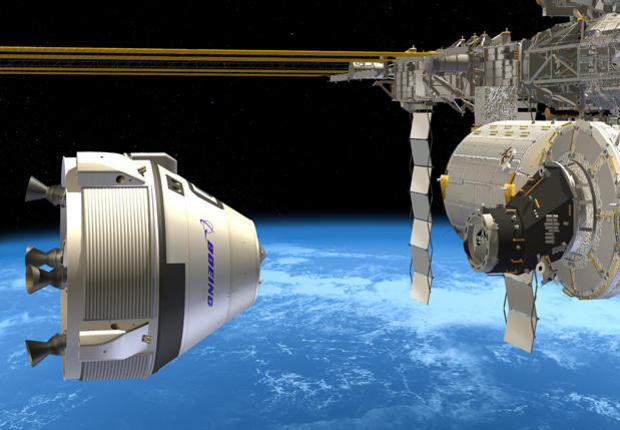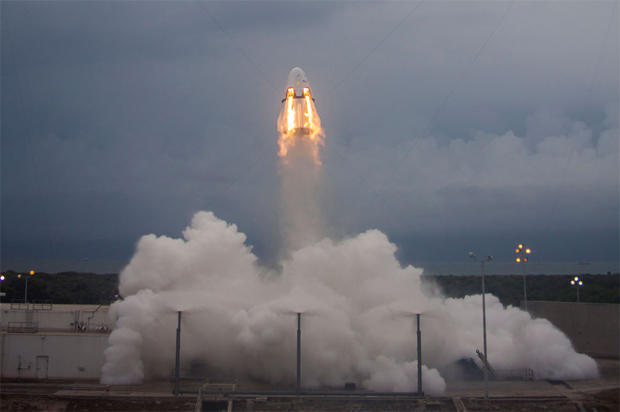NASA warns Boeing, SpaceX crew ships face delay
Even before the dramatic explosion of a SpaceX Falcon 9 rocket Thursday, NASA’s Inspector General was warning of delays in the agency’s commercial crew program, which aims to launch U.S. and partner astronauts aboard SpaceX and Boeing ferry ships in a bid to end America’s sole reliance on Russian Soyuz spacecraft.
In a report issued, by coincidence, on the same day the Falcon 9 blew up on the launch pad in Cape Canaveral, the OIG concluded “the Commercial Crew Program continues to face multiple challenges that will likely delay the first routine flight carrying NASA astronauts to the ISS until late 2018 -- more than 3 years after NASA’s original 2015 goal”
“While past funding shortfalls have contributed to the delay, technical challenges with the contractors’ spacecraft designs are now driving the schedule slippages,” the report stated. It also criticized NASA for delays responding and processing contractor concerns.
SpaceX, under a $2.6 billion contract with NASA, is building a crewed version of its Dragon cargo ship that would carry astronauts into orbit atop the company’s Falcon 9 rocket and return them to Earth, initially with a parachute descent to an ocean splashdown.
Boeing is designing its CST-100 “Starliner” capsule under a $4.2 billion contract that will use parachutes and airbags for landings at a site in the western United States. Both capsules can carry up to seven astronauts, although four-person station crews are envisioned for NASA missions with the extra space going to cargo. Both companies also are exploring possible non-station commercial use.
The commercial crew contracts require both companies to launch two test flights, one without a crew and one with two test pilots on board. Boeing plans to fly its crewed test flight with a company pilot and a NASA astronaut. SpaceX plans to use two NASA astronauts.
NASA’s internal planning schedule shows SpaceX attempting the first unpiloted test launch of its new capsule next July with the first piloted “demo” flight the following November. Boeing is on NASA’s planning schedule for an uncrewed test flight of its CST-100 in December 2017 with the company’s first piloted mission in February 2018.
It is not yet known how Thursday’s explosion might affect SpaceX’s schedule, but the crewed Dragons will be launched from complex 39A, a retired shuttle pad at the nearby Kennedy Space Center that is being modified by SpaceX. The explosion happened at complex 40 at the Cape Canaveral Air Force Station.
Even so, the mishap will require a failure investigation, work to correct whatever went wrong and extensive repairs to pad 40 that will disrupt SpaceX’s near-term launch schedule. How that might affect the company’s commercial crew effort is not yet known.
Even before the pad explosion, the commercial crew schedules were considered “soft” and many NASA insiders privately said they expected additional delays. But agency official remain hopeful one or both companies will be ready to begin routine, post-test-flight missions to the International Space Station in early to mid 2018.
But NASA Inspector General Paul Martin and his staff conclude that is unlikely.
The OIG said Boeing faces “issues relating to the effects of vibrations generated during launch and challenges regarding vehicle mass. For SpaceX, delays resulted from a change in capsule design to enable a water-based rather than ground-based landing and related concerns about the capsule taking on excessive water.”
In addition, both companies must assure NASA their spacecraft meet the agency’s stringent safety requirements for carrying crews. That process has been hampered, the IG found, by “significant delays” in NASA’s evaluation of company forwarded hazard reports “that increase the risk costly redesign work may be required late in development, which could further delay certification.”
Bill Gerstenmaier, NASA’s director of human exploration and operations, said the agency is working to improve how it processes hazard reports and that the commercial crew program “regularly evaluates the schedules of the commercial crew companies.”
“While there are risks associated with those schedules, as there are in all of NASA’s human spaceflight development activities, CCP has a robust risk management process in place,” he wrote in a letter to Martin. “Also, it is important to note that both companies continue to add margin to their certification schedules for unseen problems whenever possible.”
NASA has relied on Russian Soyuz spacecraft to carry U.S., European, Japanese and Canadian astronauts to and from the International Space Station since the space shuttle was retired in 2011.
Between 2006 and 2018, NASA’s OIG says the agency will have paid Roscosmos, the Russian federal space agency, about $3.4 billion to carry 64 NASA and partner-country astronauts to and from the space station at an average price of $53.1 million each. The current contract, covering astronauts launched through 2018 (and landing in early 2019) is $81.9 million per seat.
NASA started development of commercial crew ships in 2010, hoping for a first launch in 2015. But Congress has underfunded the program by $1.1 billion, forcing the contractors to stretch out design work, testing and production. Design challenges and changing requirements along the way have compounded the problem.
“Given (earlier) delays in the Commercial Crew Program, NASA has extended its contract with Roscosmos for astronaut transportation through 2018 at an additional cost of $490 million or $82 million a seat for six more seats,” the OIG said in its summary. “If the program experiences additional delays, NASA may need to buy additional seats from Russia to ensure a continued U.S. presence on the ISS.”
NASA plans to operate the International Space Station at least through 2024.
“I think the writing’s on the wall (that commercial crew is) not going to be ready by the time NASA has used up all the Soyuzes it has currently purchased from Russia,” Marcia Smith, editor of SpacePolicyOnline and an expert on U.S. and Russian space programs, said in an interview Friday.
To buy additional Soyuz seats, however, NASA would need another waiver to the Iran, Syria, North Korea Non-proliferation Act, which forbids U.S. purchases of high technology from nations that are not actively working to prevent weapons proliferation. Smith said the next administration will need to act quickly to enable additional Soyuz seats.
“It’s three years to build a Soyuz,” she said. “So time is running out on that. They need a contingency plan in case commercial crew is delayed or if that never arrives at all. To do that, if you’re going to be buying Soyuzes, they need to get that waiver from Congress.”
The next president, she said, will need to examine “what’s going to happen in low-Earth orbit, how are they going to ensure access to space station, or are they not? Are they just going to forget about the 2024 deadline? But right now, the U.S. government is committed to 2024, and if they want to be able to get crews back and forth, they need a contingency plan.”
For SpaceX, which has been aggressively marketing its Falcon 9 as a reliable alternative to arch-rival United Launch Alliance’s more expensive Delta 4 and Atlas 5 rockets, Thursday’s failure was a major setback, the second loss of a Falcon 9 in a little more than one year. ULA’s Atlas has logged 64 straight successes since the booster’s debut in 2002 while the Delta’s mark stands at 33 success and no failures.
SpaceX suffered its first failure in June 2015 when a station-bound Dragon cargo ship was lost due to the rupture of the booster’s second stage liquid oxygen tank while the first stage was still firing.
SpaceX blamed that failure on a sub-standard strut inside the second stage liquid oxygen tank that broke free in flight, releasing an internal helium pressurization bottle that shot to the top of the tank and triggered its breakup.
Thursday’s on-pad failure also appeared to originate with the second stage, although no details have been released and it’s not known if there was any commonality or generic issue.
As such, it is not known what might be required to fix the rocket or how long it might take to repair damaged ground facilities. While near-term flights will face extended delays, it is too early to say what impact the failure might have on SpaceX’s commercial crew project.
Even so, SpaceX founder and chief designer Elon Musk said the abort system that will be built into the piloted version of the Dragon spacecraft would save a crew from a similar on-pad malfunction, quickly boosting the capsule away from the rocket for a parachute descent. SpaceX successfully tested its abort system in May 2015.
In a Tweet Thursday, Musk answered a question from a Twitter follower by saying the explosion “seems instant from a human perspective, but it (is) really a fast fire, not an explosion. Dragon would have been fine.”



